The Relationship between Climate Change, Variability, and Food Security: Understanding the Impacts and Building Resilient Food Systems in West Pokot County, Kenya
Abstract
1. Introduction
2. Data and Methods
2.1. Site Selection
2.2. Sample Size and Sampling Procedure
- n—the sample size
- N—the target population (93,777)
- CV—the coefficient of variation (0.5)
- ϵ—the tolerance of desired level of confidence at 95% level (0.05)
- (93777 × 0.52)/ (0.52 + (93777 − 1) 0.052) = 23444/234.69 = 100 respondents
2.3. Data Acquisition
2.4. Estimation Strategy
2.5. Image Processing
2.6. Data Analysis
3. Results
3.1. Characterizing Annual and Seasonal Rainfall and Temperature from 1980–2011 in West Pokot County
3.1.1. Rainfall Trend Analysis
3.1.2. Temperature Trend Analysis
3.2. Land Use Land Cover (LULC) Changes
3.3. The Phenology of Agricultural Vegetation in West Pokot County
Analysis of NDVI Anomalies in West Pokot County
3.4. Perception of the Relationship between Food Insecurity and Climate Change and Variability in the Area
3.4.1. Effect of Climate Variability on Crop Production
3.4.2. Change in Crop Growing Seasons
3.4.3. Perceived Changes in Crop Yield over Time
3.4.4. Weather Forecast Information Access by the Respondents
3.4.5. Measures Taken to Reduce Exposure to the Impacts of Climate Change
4. Discussion
4.1. Characterizing Annual and Seasonal Rainfall and Temperature from 1980–2011 in West Pokot County
4.2. Land Use Land Cover (LULC) Changes
4.3. The Phenology of Agricultural Vegetation in West Pokot County
4.4. Perceptions of the Relationships between Food Insecurity and Climate Change and Variability in West Pokot County
4.4.1. Perception of climate change and climate variability in West Pokot County
4.4.2. Perception of Impacts of Climate Change and Variability on Crop Productivity
4.4.3. Perception of Weather Forecast Information
4.5. Measures Taken to Reduce Climate Change Impacts on Food Security
5. Conclusions
Author Contributions
Funding
Institutional Review Board Statement
Informed Consent Statement
Data Availability Statement
Acknowledgments
Conflicts of Interest
References
- Parry, M.L.; Rosenzweig, C.; Iglesias, A.; Livermore, M.; Fischer, G. Effects of climate change on global food production under SRES emissions and socio-economic scenarios. Glob. Environ. Chang. 2004, 14, 53–67. [Google Scholar] [CrossRef]
- IPCC. Climate Change 2007—The Physical Science Basis: Working Group I Contribution to the Fourth Assessment Report of the IPCC (Climate Change 2007); Solomon, S., Qin, D., Manning, M., Marquis, M., Averyt, K., Tignor, M.M.B., Miller, H.L., Chen, Z., Eds.; IPCC: Geneva, Switzerland; Cambridge University Press: New York, NY, USA, 2007; ISBN 0521705967.
- Ojwang’, G.O.; Agatsiva, J.; Situma, C. Analysis of Climate Change and Variability Risks in the Smallholder Sector; Case studies of the Laikipia and Narok Districts representing major agro-ecological zones in Kenya; Department of Resource Surveys and Remote Sensing (DRSRS) and FAO: Rome, Italy, 2010. [Google Scholar]
- Belloumi, M. Investigating the linkage between climate variables and food security in ESA countries. Reg. Environ. Chang. 2014, 42, 172–186. [Google Scholar]
- Mongi, H.; Majule, A.E.; Lyimo, J.G. Vulnerability and adaptation of rain fed agriculture to climate change and variability in semi-arid Tanzania. Afr. J. Environ. Sci. Technol. 2010, 4, 371–381. [Google Scholar]
- Mesike, C.S.; Esekhade, T.U. Rainfall variability and rubber production in Nigeria. African J. Environ. Sci. Technol. 2014, 8, 54–57. [Google Scholar] [CrossRef]
- International Water Management Institute (IWMI). Managing Water for Rainfed Agriculture; International Water Management Institute (IWMI): Colombo, Sri Lanka, 2010. [Google Scholar] [CrossRef][Green Version]
- Krishnamurthy, P.K.; Hobbs, C.; Matthiasen, A.; Hollema, S.R.; Choularton, R.J.; Pahari, K.; Kawabata, M. Climate Risk and Food Security in Nepal—Analysis of Climate Impacts on Food Security and Livelihoods; CGIAR Research Program on Climate Change, Agriculture and Food Security (CCAFS): Copenhagen, Denmark, 2013; Available online: https://ccafs.cgiar.org/resources/publications/climate-risk-and-food-security-nepal-analysis-climate-impacts-food (accessed on 10 September 2021).
- Technical Centre for Agricultural and Rural Cooperation. Spore Special Issue: Climate Change. Available online: https://cgspace.cgiar.org/handle/10568/76898 (accessed on 10 September 2021).
- Adams, R.M.; West, J.A.E. The implications of global change for western agriculture. West. J. Agric. Econ. 1988, 13, 348–356. [Google Scholar]
- Jat, M.L.; Stirling, C.M.; Jat, H.S.; Tetarwal, J.P.; Jat, R.K.; Singh, R.; Lopez-Ridaura, S.; Shirsath, P.B. Soil processes and wheat cropping under emerging climate change scenarios in South Asia. Adv. Agron. 2018, 148, 111–171. [Google Scholar]
- Vigren Skogseid, M. Climate Change in Kenya: A Review of Literature and Evaluation of Temperature and Precipitation Data. Bachelor’s Thesis, Lund University, Lund, Sweden, 2017. [Google Scholar]
- Fazal, S.A.; Wahab, S.A. Economic Impact of Climate Change on Agricultural Sector: A review. J. Transform. Entrep. 2013, 1, 39–49. [Google Scholar]
- FAO. Climate Change and Food Security: A Framework Document; Food and Agricultural Organization of United Nation: Rome, Italy, 2008. [Google Scholar]
- Chuen Khee, P.; Yet Mee, L.; Chee Keong, C. The Economic Impact of Climate Change on Food Security in Malaysia; University Library of Munich: Munich, Germany, 2011. [Google Scholar]
- Neufeldt, H.; Kristjanson, P.; Thorlakson, T.; Gassner, A.; Norton-Griffiths, M.; Place, F.; Langford, K. Making Climate-Smart Agriculture Work for the Poor; World Agroforestry Centre (ICRAF): Nairobi, Kenya, 2011. [Google Scholar]
- FAO; IFAD; UNICEF; WFP; WHO. The State of Food Security and Nutrition in the World 2017. Building Resilience for Peace and Food Security; FAO: Rome, Italy, 2017; ISBN 978-92-5-109888-2. Available online: www.fao.org/3/a-I7695e.pdf (accessed on 10 September 2021).
- Wheeler, T.; von Braun, J. Climate change impacts on global food security. Science 2013, 341, 508–513. [Google Scholar] [CrossRef]
- Rötter, R.; Sehomi, F.; Höhn, J.; Niemi, J.; den Berg, M. On the Use of Agricultural System Models for Exploring Technological Innovations Across Scales in Africa: A Critical Review; University of Bonn, Center for Development Research (ZEF): Bonn, Germany, 2016. [Google Scholar]
- Stocker, T.; Qin, D.; Plattner, G.; Tignor, M.; Allen, S.; Boschung, J.; Nauels, A.; Xia, Y.; Bex, V.; Midgley, P. IPCC, 2013: Summary for Policymakers in Climate Change 2013: The Physical Science Basis, Contribution of Working Group I to the Fifth Assessment Report of the Intergovernmental Panel on Climate Change; Cambridge University Press: New York, NY, USA, 2013. [Google Scholar]
- Arndt, C.; Farmer, W.; Strzepek, K.; Thurlow, J. Climate Change, Agriculture and Food Security in Tanzania; The United Nations University World Institute for Development Economics Research (UNU-WIDER): Helsinki, Finland, 2011. [Google Scholar]
- Manei, N. Integration of Indigenous Knowledge with Information and Communication Technologies in Coping with Effects of Climate Change and Variability on Agriculture in Kajiado County, Kenya; University of Nairobi: Nairobi, Kenya, 2013. [Google Scholar]
- MEMR (Ministry of Environment and Mineral Resources). National Climate Change Response Strategy: Executive Brief. Minist. Environ. Miner. Resour. Gov. Kenya (GoK), Nairobi. 2010. Available online: http://www.environment.go.ke/wp-content/documents/complete%20nccrs%20executive%20brief.pdf (accessed on 10 September 2021).
- USAID. Food Security in Kenya: Situation Report; United States Agency International Development: Nairobi, Kenya, 2013. [Google Scholar]
- Asiti, W. Smallholder Farmers’ Perception of the Impacts of Climate Change and Variability on Rain-fed Agricultural Practices in Semi-arid and Sub-humid Regions of Kenya; Kenya National Youth Conference on Climate Change: Mbagathi, Kenya, 2010. [Google Scholar]
- Mutimba, S.; Mayieko, S.; Olum, P.; Wanyama, K. Climate Change Vulnerability and Adaptation Preparedness in Kenya; Heinrich Böll Stiftung, East and Horn Africa: Nairobi, Kenya, 2010; Available online: http://www.boell.or.ke/downloads/Kenya_Climate_Change_Adaptation_Preparedness.pdf (accessed on 10 September 2021)ISBN 9966-7172-3-4.
- Wakibi, S.; Gichuhi, W.; Kabira, W.M. Food Security Score for Kenya. J. Afr. Women’s Stud. Cent. 2015, 1, 1–12. [Google Scholar]
- Ng’ang’a, T.K. Women’s Experiences on Food Security in Kenya: Major Challenges That They Face. Pathways to African Feminism and Development. J. Afr. Women’s Stud. Cent. 2015, 1, 2. [Google Scholar]
- Roncoli, C. Ethnographic and participatory approaches to research on farmers’ responses to climate predictions. Clim. Res. 2006, 33, 81–99. [Google Scholar] [CrossRef]
- Kabubo-Mariara, J.; Kabara, M. Climate change and food security in Kenya. In Agricultural Adaptation to Climate Change in Africa; Routledge: London, UK, 2018; pp. 55–80. [Google Scholar]
- Zinyengere, N.; Crespo, O.; Hachigonta, S.; Tadross, M. Local impacts of climate change and agronomic practices on dry land crops in Southern Africa. Agric. Ecosyst. Environ. 2014, 197, 1–10. [Google Scholar] [CrossRef]
- Fuchs, L.E.; Orero, L.; Namoi, N.; Neufeldt, H. How to effectively enhance sustainable livelihoods in smallholder systems: A comparative study from Western Kenya. Sustainability 2019, 11, 1564. [Google Scholar] [CrossRef]
- Ramisch, J.J. They don’t know what they are talking about’: Soil fertility knowledge, cognitive dissonance, and experimental practice in western Kenya. Geoforum 2014, 55, 120–132. [Google Scholar] [CrossRef]
- Silvestri, S.; Bryan, E.; Ringler, C.; Herrero, M.; Okoba, B. Climate change perception and adaptation of agro-pastoral communities in Kenya. Reg. Environ. Chang. 2012, 12, 791–802. [Google Scholar] [CrossRef]
- Osbahr, H.; Dorward, P.; Stern, R.; Cooper, S. Supporting agricultural innovation in Uganda to respond to climate risk: Linking climate change and variability with farmer perceptions. Exp. Agric. 2011, 47, 293–316. [Google Scholar] [CrossRef]
- Simelton, E.; Quinn, C.H.; Batisani, N.; Dougill, A.J.; Dyer, J.C.; Fraser, E.D.G.; Mkwambisi, D.; Sallu, S.; Stringer, L.C. Is rainfall really changing? Farmers’ perceptions, meteorological data, and policy implications. Clim. Dev. 2013, 5, 123–138. [Google Scholar] [CrossRef]
- Hasan, M.K.; Kumar, L. Comparison between meteorological data and farmer perceptions of climate change and vulnerability in relation to adaptation. J. Environ. Manag. 2019, 237, 54–62. [Google Scholar] [CrossRef]
- Peltonen-Sainio, P.; Jauhiainen, L.; Honkavaara, E.; Wittke, S.; Karjalainen, M.; Puttonen, E. Pre-crop values from satellite images for various previous and subsequent crop combinations. Front. Plant Sci. 2019, 10, 462. [Google Scholar] [CrossRef] [PubMed]
- Darkoh, M.B.K. Regional perspectives on agriculture and biodiversity in the drylands of Africa. J. Arid Environ. 2003, 54, 261–279. [Google Scholar] [CrossRef]
- Cihlar, J.; Laurent, L.S.; Dyer, J.A. Relation between the normalized difference vegetation index and ecological variables. Remote Sens. Environ. 1991, 35, 279–298. [Google Scholar] [CrossRef]
- Ma, M.; Frank, V. Interannual variability of vegetation cover in the Chinese Heihe River Basin and its relation to meteorological parameters. Int. J. Remote Sens. 2006, 27, 3473–3486. [Google Scholar] [CrossRef]
- Nagai, S.; Ichii, K.; Morimoto, H. Interannual variations in vegetation activities and climate variability caused by ENSO in tropical rainforests. Int. J. Remote Sens. 2007, 28, 1285–1297. [Google Scholar] [CrossRef]
- Mabuchi, K.; Sato, Y.; Kida, H. Climatic impact of vegetation change in the Asian tropical region. Part I: Case of the Northern Hemisphere summer. J. Clim. 2005, 18, 410–428. [Google Scholar] [CrossRef]
- West Pokot County. West Pokot County Integrated Development Plan, CIDP (2018–2022); West Pokot County: Kapenguria, Kenya, 2018. [Google Scholar]
- Ogola, E.O.; Chepkorir, E.; Sang, R.; Tchouassi, D.P. A previously unreported potential malaria vector in a dry ecology of Kenya. Parasites Vectors 2019, 12, 1–6. [Google Scholar] [CrossRef]
- West Pokot County. West Pokot County Integrated Development Plan, CIDP (2013–2017); West Pokot County: Kapenguria, Kenya, 2013. [Google Scholar]
- Israel, G.D. Sampling the Evidence of Extension Program Impact; Program evaluation and organizational development, IFAS, University of Florida: Gainesville, FL, USA, 1992. [Google Scholar]
- Cox, D.R. Two Further Applications of a Model for Binary Regression. Biometrika 1958, 45, 562–565. [Google Scholar] [CrossRef]
- Amber, C. ERDAS 2011 Software. GeoInformatics 2011, 4, 32–34. Available online: https://www.gim-international.com/content/news/erdas-2011-software (accessed on 10 September 2021).
- ArcGIS [GIS Software]; Version 10.0; Environmental Systems Research Institute, Inc.: Redlands, CA, USA, 2010; Available online: https://enterprise.arcgis.com/en/portal/10.3/use/copyright-information.htm (accessed on 10 September 2021).
- IPCC. 2006 National Greenhouse Gas Inventory Guidelines; Eggelston, S., Buendia, L., Miwa, K., Ngara, T., Tanabe, K., Eds.; IPCC: Kanagawa, Japan, 2006.
- R Core Team. R: A Language and Environment for Statistical Computing. R Foundation for Statistical Computing, Vienna, Austria. 2021. Available online: https://www.R-project.org (accessed on 10 September 2021).
- Wickham, H.; Averick, M.; Bryan, J.; Chang, W.; McGowan, L.D.; François, R.; Grolemund, G.; Hayes, A.; Henry, L.; Hester, J.; et al. Welcome to the {tidyverse}. J. Open Source Softw. 2019, 4, 1686. [Google Scholar] [CrossRef]
- Wickham, H.; Seidel, D. scales: Scale Functions for Visualization. R Package Version 1.1.1. 2020. Available online: https://CRAN.Rproject.org/package=scales (accessed on 10 September 2021).
- Zeileis, A.; Grothendieck, G. zoo: S3 Infrastructure for Regular and Irregular Time Series. J. Stat. Softw. 2005, 14, 1–27. [Google Scholar] [CrossRef]
- De Mendiburu, F. Agricolae: Statistical Procedures for Agricultural Research. R package, Version 1.3–5. 2021. Available online: https://CRAN.R-project.org/package=survival (accessed on 10 September 2021).
- Luedeling, E.; Sileshi, G.; Dietz, J. Advances in Agroforestry. In Advances in Agroforestry; Kumar, B.M., Nair, P.K.R., Eds.; Springer Science and Business Media: New York, NY, USA, 2011; pp. 61–83. [Google Scholar]
- Fox, J.; Weisberg, S. An {R} Companion to Applied Regression, 3rd ed.; Sage: Thousand Oaks, CA, USA, 2019; Available online: https://socialsciences.mcmaster.ca/jfox/Books/Companion/ (accessed on 10 September 2021).
- Hyndman, R.; Athanasopoulos, G.; Bergmeir, C.; Caceres, G.; Chhay, L.; O’Hara-Wild, M.; Petropoulos, F.; Razbash, S.; Wang, E.; Yasmeen, F. {forecast}: Forecasting functions for time series and linear models. 2021. R package, Version 8.15. Available online: https://pkg.robjhyndman.com/forecast/ (accessed on 10 September 2021).
- Collins, J.M. Temperature variability over Africa. J. Clim. 2011, 24, 3649–3666. [Google Scholar] [CrossRef]
- Ogutu, J.O.; Piepho, H.-P.; Said, M.Y.; Ojwang, G.O.; Njino, L.W.; Kifugo, S.C.; Wargute, P.W. Extreme wildlife declines and concurrent increase in livestock numbers in Kenya: What are the causes? PLoS ONE 2016, 11. [Google Scholar]
- Issahaku, A.-R.; Campion, B.B.; Edziyie, R. Rainfall and temperature changes and variability in the Upper East Region of Ghana. Earth Sp. Sci. 2016, 3, 284–294. [Google Scholar] [CrossRef]
- Bonfils, S. Trend analysis of the mean annual temperature in Rwanda during the last fifty two years. J. Environ. Prot. 2012, 3, 538–551. [Google Scholar] [CrossRef]
- King’Uyu, S.M.; Ogallo, L.A.; Anyamba, E.K. Recent trends of minimum and maximum surface temperatures over Eastern Africa. J. Clim. 2000, 13, 2876–2886. [Google Scholar] [CrossRef]
- Kurukulasuriya, P. Economic Impact of Climate Change on African Agriculture; Yale University: New Haven, CT, USA, 2006. [Google Scholar]
- Conway, D.; Schipper, E.L.F. Adaptation to climate change in Africa: Challenges and opportunities identified from Ethiopia. Glob. Environ. Chang. 2011, 21, 227–237. [Google Scholar] [CrossRef]
- Hulme, M.; Doherty, R.; Ngara, T.; New, M.; Lister, D. African climate change: 1900–2100. Clim. Res. 2001, 17, 145–168. [Google Scholar] [CrossRef]
- Teixeira, E.I.; Fischer, G.; Van Velthuizen, H.; Walter, C.; Ewert, F. Global hot-spots of heat stress on agricultural crops due to climate change. Agric. For. Meteorol. 2013, 170, 206–215. [Google Scholar] [CrossRef]
- Ainsworth, E.A.; Ort, D.R. How do we improve crop production in a warming world? Plant Physiol. 2010, 154, 526–530. [Google Scholar] [CrossRef]
- Belachew, A. Dry-Spell Analysis for Studying the Sustainability of Rain-Fed Agriculture in Ethiopia: The Case of the Arbaminch Area; International Commission on Irrigation and Drainage (ICID): New Delhi, India; Institute for the Semi-Arid Tropics, Direction de la meteorology nationale du Niger: Addis Ababa, Ethiopia, 2000. [Google Scholar]
- Akponikpe, P.B.I.; Michels, K.; Bielders, C.L. Integrated nutrient management of pearl millet in the Sahel combining cattle manure, crop residue and mineral fertilizer. Exp. Agric. 2008, 44, 453–472. [Google Scholar] [CrossRef]
- Mzezewa, J.; Misi, T.; Van Rensburg, L. Characterisation of rainfall at a semi-arid ecotope in the Limpopo Province (South Africa) and its implications for sustainable crop production. Water 2010, 36, 19–26. [Google Scholar] [CrossRef]
- Githui, F.; Gitau, W.; Mutua, F.; Bauwens, W. Climate change impact on SWAT simulated streamflow in western Kenya. Int. J. Climatol. A J. R. Meteorol. Soc. 2009, 29, 1823–1834. [Google Scholar] [CrossRef]
- Rao, K.P.C.; Verchot, L.V.; Laarman, J. Adaptation to Climate Change through Sustainable Management and Development of Agroforestry Systems. J. SAT Agric. Res. 2007, 4, 1–30. [Google Scholar]
- Watson, R.T.; Zinyowera, M.C.; Moss, R.H.; Dokken, D.J. The Regional Impacts of Climate Change: An Assessment of Vulnerability; Cambridge University Press: Cambridge, UK, 1998. [Google Scholar]
- IPCC. Climate Change 2007: Synthesis Report. Contribution of Working Groups I, II and III to the Fourth Assessment Report of the Intergovernmental Panel on Climate Change; Core Writing Team, Pachauri, R.K., Reisinger, A., Eds.; IPCC: Geneva, Switzerland, 2007.
- Funk, C.C.; Brown, M.E. Declining global per capita agricultural production and warming oceans threaten food security. Food Secur. 2009, 1, 271–289. [Google Scholar] [CrossRef]
- Lyon, B.; Vigaud, N. Unraveling East Africa’s climate paradox. Clim. Extrem. Patterns Mech. 2017, 265, 281. [Google Scholar]
- How Jin Aik, D.; Ismail, M.H.; Muharam, F.M.; Alias, M.A. Evaluating the impacts of land use/land cover changes across topography against land surface temperature in Cameron Highlands. PLoS ONE 2021, 16, e0252111. [Google Scholar]
- Fall, S.; Niyogi, D.; Gluhovsky, A.; Pielke Sr, R.A.; Kalnay, E.; Rochon, G. Impacts of land use land cover on temperature trends over the continental United States: Assessment using the North American Regional Reanalysis. Int. J. Climatol. 2010, 30, 1980–1993. [Google Scholar] [CrossRef]
- Ministry of Environment and Mineral Resources (MEMR). Master Plan for the Conservation and Sustainable Management of Water Catchment Areas of Kenya; Government of Kenya: Nairobi, Kenya, 2012.
- County Government of West Pokot. West Pokot County Annual Development Plan 2015/2016; County Government of West Pokot: Kapenguria, Kenya, 2014.
- Brink, A.B.; Eva, H.D. Monitoring 25 years of land cover change dynamics in Africa: A sample based remote sensing approach. Appl. Geogr. 2009, 29, 501–512. [Google Scholar] [CrossRef]
- Wasige, J.E.; Groen, T.A.; Smaling, E.; Jetten, V. Monitoring basin-scale land cover changes in Kagera Basin of Lake Victoria using ancillary data and remote sensing. Int. J. Appl. Earth Obs. Geoinf. 2013, 21, 32–42. [Google Scholar] [CrossRef]
- Amsalu, A.; Stroosnijder, L.; de Graaff, J. Long-term dynamics in land resource use and the driving forces in the Beressa watershed, highlands of Ethiopia. J. Environ. Manag. 2007, 83, 448–459. [Google Scholar] [CrossRef]
- Dessie, G.; Kleman, J. Pattern and magnitude of deforestation in the South Central Rift Valley Region of Ethiopia. Mt. Res. Dev. 2007, 27, 162–168. [Google Scholar] [CrossRef]
- Du, X.; Jin, X.; Yang, X.; Yang, X.; Zhou, Y. Spatial pattern of land use change and its driving force in Jiangsu Province. Int. J. Environ. Res. Public Health 2014, 11, 3215–3232. [Google Scholar] [CrossRef]
- Kahuthu, R.; Muchoki, C.; Nyaga, C. Kakamega District Strategic Plan 2005–2010 for Implementation of the National Population Policy for Sustainable Development; National Coordinating Agency for Population and Development (NCAPD): Nairobi, Kenya, 2005. [Google Scholar]
- KNBS (Kenya National Bureau of Statistics). 2009 Kenya Population and Housing Census; KNBS: Nairobi, Kenya, 2010.
- Ministry of State for Development of Northern Kenya and Other Arid Lands Arid Lands Resource Management Project II, Office of The Prime Minister. West Pokot Drought Monitoring Bulletin; Government of the Republic of Kenya, Ministry of State for Development of Northern Kenya and Other Arid Lands Arid Lands Resource Management Project II, Office of The Prime Minister: Nairobi, Kenya, 2010.
- Chu, D.; Lu, L.; Zhang, T. Sensitivity of normalized difference vegetation index (NDVI) to seasonal and interannual climate conditions in the Lhasa area, Tibetan plateau, China. Arctic, Antarct. Alp. Res. 2007, 39, 635–641. [Google Scholar] [CrossRef]
- Pricope, N.G.; Husak, G.; Lopez-Carr, D.; Funk, C.; Michaelsen, J. The climate-population nexus in the East African Horn: Emerging degradation trends in rangeland and pastoral livelihood zones. Glob. Environ. Chang. 2013, 23, 1525–1541. [Google Scholar] [CrossRef]
- Omondi, P.A.; Awange, J.L.; Forootan, E.; Ogallo, L.A.; Barakiza, R.; Girmaw, G.B.; Fesseha, I.; Kululetera, V.; Kilembe, C.; Mbati, M.M.; et al. Changes in temperature and precipitation extremes over the Greater Horn of Africa region from 1961 to 2010. Int. J. Climatol. 2014, 34, 1262–1277. [Google Scholar] [CrossRef]
- Regmi, R.; Ma, Y.; Ma, W.; Baniya, B.; Bashir, B. Interannual Variation of NDVI, Precipitation and Temperature during the Growing Season in Langtang National Park, Central Himalaya, Nepal. Appl. Ecol. Environ. Sci. 2020, 8, 218–228. [Google Scholar]
- Achard, F.; Estreguil, C. Forest classification of Southeast Asia using NOAA AVHRR data. Remote Sens. Environ. 1995, 54, 198–208. [Google Scholar] [CrossRef]
- Kisaka, M.O.; Mucheru-Muna, M.; Ngetich, F.K.; Mugwe, J.N.; Mugendi, D.; Mairura, F. Rainfall variability, drought characterization, and efficacy of rainfall data reconstruction: Case of Eastern Kenya. Adv. Meteorol. 2015, 2015. [Google Scholar] [CrossRef]
- Anyamba, A.; Tucker, C.J. Analysis of Sahelian vegetation dynamics using NOAA-AVHRR NDVI data from 1981–2003. J. Arid Environ. 2005, 63, 596–614. [Google Scholar] [CrossRef]
- Martiny, N.; Camberlin, P.; Richard, Y.; Philippon, N. Compared regimes of NDVI and rainfall in semi-arid regions of Africa. Int. J. Remote Sens. 2006, 27, 5201–5223. [Google Scholar] [CrossRef]
- Malo, A.R.; Nicholson, S.E. A study of rainfall and vegetation dynamics in the African Sahel using normalized difference vegetation index. J. Arid Environ. 1990, 19, 1–24. [Google Scholar] [CrossRef]
- Barron, J.; Rockström, J.; Gichuki, F.; Hatibu, N. Dry spell analysis and maize yields for two semi-arid locations in east Africa. Agric. For. Meteorol. 2003, 117, 23–37. [Google Scholar] [CrossRef]
- Harvest Choice Rainfall Variability and Crop Yield Potential; International Food Policy Research Institute: Washington, DC, USA; University of Minnesota: St. Paul, MN, USA, 2010.
- Sánchez-Cortés, M.S.; Chavero, E.L. Indigenous perception of changes in climate variability and its relationship with agriculture in a Zoque community of Chiapas, Mexico. Clim. Chang. 2011, 107, 363–389. [Google Scholar] [CrossRef]
- Liebmann, B.; Hoerling, M.P.; Funk, C.; Bladé, I.; Dole, R.M.; Allured, D.; Quan, X.; Pegion, P.; Eischeid, J.K. Understanding recent eastern Horn of Africa rainfall variability and change. J. Clim. 2014, 27, 8630–8645. [Google Scholar] [CrossRef]
- Howe, P.D.; Thaker, J.; Leiserowitz, A. Public perceptions of rainfall change in India. Clim. Chang. 2014, 127, 211–225. [Google Scholar] [CrossRef]
- Ahmed, S.A.; Diffenbaugh, N.S.; Hertel, T.W.; Lobell, D.B.; Ramankutty, N.; Rios, A.R.; Rowhani, P. Climate volatility and poverty vulnerability in Tanzania. Glob. Environ. Chang. 2011, 21, 46–55. [Google Scholar] [CrossRef]
- Below, T.B.; Schmid, J.C.; Sieber, S. Farmers’ knowledge and perception of climatic risks and options for climate change adaptation: A case study from two Tanzanian villages. Reg. Environ. Chang. 2015, 15, 1169–1180. [Google Scholar] [CrossRef]
- Rowhani, P.; Lobell, D.B.; Linderman, M.; Ramankutty, N. Climate variability and crop production in Tanzania. Agric. For. Meteorol. 2011, 151, 449–460. [Google Scholar] [CrossRef]
- Chen, D.; Whalen, J.K. Climate change in the North China Plain: Smallholder farmer perceptions and adaptations in Quzhou County, Hebei Province. Clim. Res. 2016, 69, 261–273. [Google Scholar] [CrossRef][Green Version]
- Kassie, B.T.; Hengsdijk, H.; Rötter, R.; Kahiluoto, H.; Asseng, S.; Van Ittersum, M. Adapting to climate variability and change: Experiences from cereal-based farming in the Central Rift and Kobo Valleys, Ethiopia. Environ. Manag. 2013, 52, 1115–1131. [Google Scholar] [CrossRef]
- Le Dang, H.; Li, E.; Nuberg, I.; Bruwer, J. Understanding farmers’ adaptation intention to climate change: A structural equation modelling study in the Mekong Delta, Vietnam. Environ. Sci. Policy 2014, 41, 11–22. [Google Scholar] [CrossRef]
- Panda, A. Exploring climate change perceptions, rainfall trends and perceived barriers to adaptation in a drought affected region in India. Nat. Hazards 2016, 84, 777–796. [Google Scholar] [CrossRef]
- Mulenga, B.P.; Wineman, A.; Sitko, N.J. Climate trends and farmers’ perceptions of climate change in Zambia. Environ. Manag. 2017, 59, 291–306. [Google Scholar] [CrossRef]
- Slegers, M.F.W. “If only it would rain”: Farmers’ perceptions of rainfall and drought in semi-arid central Tanzania. J. Arid Environ. 2008, 72, 2106–2123. [Google Scholar] [CrossRef]
- Moyo, M.; Mvumi, B.M.; Kunzekweguta, M.; Mazvimavi, K.; Craufurd, P.; Dorward, P. Farmer perceptions on climate change and variability in semi-arid Zimbabwe in relation to climatology evidence. African Crop Sci. J. 2012, 20, 317–335. [Google Scholar]
- Carmin, J.; Tierney, K.; Chu, E.; Hunter, L.M.; Roberts, J.T.; Shi, L. Adaptation to climate change. In Climate Change and Society: Sociological Perspectives; Carmin, J.; Tierney, K.; Chu, E.; Hunter, L.M.; Roberts, J.T.; Shi, L. Oxford University Press: New York, NY, USA, 2015; pp. 164–198. ISBN 13: 9780199356102. [Google Scholar]
- Ayugi, B.O.; Wen, W.; Chepkemoi, D. Analysis of spatial and temporal patterns of rainfall variations over Kenya. Studies 2016, 6, 69–83. [Google Scholar]
- Lobell, D.B.; Burke, M.B.; Tebaldi, C.; Mastrandrea, M.D.; Falcon, W.P.; Naylor, R.L. Prioritizing Climate Change Adaptation Needs for Food Security in 2030. Science. 2008, 319, 607–610. [Google Scholar] [CrossRef]
- Knox, J.; Hess, T.; Daccache, A.; Wheeler, T. Climate change impacts on crop productivity in Africa and South Asia. Environ. Res. Lett. 2012, 7, 034032. [Google Scholar] [CrossRef]
- Waha, K.; Müller, C.; Bondeau, A.; Dietrich, J.P.; Kurukulasuriya, P.; Heinke, J.; Lotze-Campen, H. Adaptation to climate change through the choice of cropping system and sowing date in sub-Saharan Africa. Glob. Environ. Chang. 2013, 23, 130–143. [Google Scholar] [CrossRef]
- Omoyo, N.N.; Wakhungu, J.; Oteng’i, S. Effects of climate variability on maize yield in the arid and semi arid lands of lower eastern Kenya. Agric. Food Secur. 2015, 4, 1–13. [Google Scholar] [CrossRef]
- Mubaya, C.P.; Njuki, J.; Mutsvangwa, E.P.; Mugabe, F.T.; Nanja, D. Climate variability and change or multiple stressors? Farmer perceptions regarding threats to livelihoods in Zimbabwe and Zambia. J. Environ. Manag. 2012, 102, 9–17. [Google Scholar] [CrossRef]
- Kangalawe, R.Y.M.; Lyimo, J.G. Climate change, adaptive strategies and rural livelihoods in semiarid Tanzania. Natural Resour. 2013, 4, 266–278. [Google Scholar] [CrossRef]
- Kalungu, J.W.; Harris, D. Smallholder farmers’ perception of the impacts of climate change and variability on rain-fed agricultural practices in semi-arid and sub-humid regions of Kenya. J. Environ. Earth Sci. 2013, 3, 129–140. [Google Scholar]
- Fischer, G.; van Velthuizen, H.T. Climate Change and Global Agricultural Potential Project: A Case of Kenya; IIASA Working Paper; IIASA: Laxenburg, Austria, 1996. [Google Scholar]
- Jones, P.G.; Thornton, P.K. The potential impacts of climate change on maize production in Africa and Latin America in 2055. Glob. Environ. Chang. 2003, 13, 51–59. [Google Scholar] [CrossRef]
- Ngigi, S.N. Climate Change Adaptation Strategies: Water Resources Management Options for Smallholder Farming Systems in Sub-Saharan Africa; The Earth Institute at Columbia University: New York, NY, USA, 2009. [Google Scholar]
- Gwimbi, P. Cotton farmers’ vulnerability to climate change in Gokwe District (Zimbabwe): Impact and influencing factors. JAMBA J. Disaster Risk Stud. 2009, 2, 81–92. [Google Scholar] [CrossRef]
- Ziervogel, G. Targeting seasonal climate forecasts for integration into household level decisions: The case of smallholder farmers in Lesotho. Geogr. J. 2004, 170, 6–21. [Google Scholar] [CrossRef]
- Lemos, M.C.; Dilling, L. Equity in forecasting climate: Can science save the world’s poor? Sci. Public Policy 2007, 34, 109–116. [Google Scholar] [CrossRef]
- Chaudhury, M.; Kristjanson, P.M.; Kyagazze, F.; Naab, J.B.; Neelormi, S. Participatory Gender-Sensitive Approaches for Addressing Key Climate Change-Related Research Issues: Evidence from Bangladesh, Ghana, and Uganda; Working Paper 19; CGIAR Research Program on Climate Change, Agriculture and Food Security (CCAFS): Wageningen, The Netherlands, 2012. [Google Scholar]
- Cherotich, V.K.; Saidu, O.; Bebe, B.O. Access to climate change information and support services by the vulnerable groups in semi-arid Kenya for adaptive capacity development. African Crop Sci. J. 2012, 20, 169–180. [Google Scholar]
- Moghariya, D.P.; Smardon, R.C. Rural perspectives of climate change: A study from Saurastra and Kutch of Western India. Public Underst. Sci. 2014, 23, 660–677. [Google Scholar] [CrossRef]
- Hansen, J.W.; Baethgen, W.E.; Osgood, D.E.; Ceccato, P.N.; Ngugi, R.K. Innovations in climate risk management: Protecting and building rural livelihoods in a variable and changing climate. J. Semi-Arid. Trop. Agric. Res. 2007, 4, 88–99. [Google Scholar]
- Ballantyne, P.; Labelle, R.; Rudgard, S. Information and knowledge management: Challenges for capacity builders. Policy Manag. Br. 2000, 11. Available online: https://www.researchgate.net/profile/Stephen-Rudgard/publication/265072732_Information_and_Knowledge_Management_Challenges_for_Capacity_Builders/links/54ac89310cf23c69a2b7e887/Information-and-Knowledge-Management-Challenges-for-Capacity-Builders.pdf (accessed on 10 September 2021).
- Roncoli, C.; Jost, C.; Kirshen, P.; Sanon, M.; Ingram, K.T.; Woodin, M.; Somé, L.; Ouattara, F.; Sanfo, B.J.; Sia, C.; et al. From accessing to assessing forecasts: An end-to-end study of participatory climate forecast dissemination in Burkina Faso (West Africa). Clim. Chang. 2009, 92, 433–460. [Google Scholar] [CrossRef]
- Kogan, F.N. Global drought watch from space. Bull. Am. Meteorol. Soc. 1997, 78, 621–636. [Google Scholar] [CrossRef]
- Egeru, A. Role of indigenous knowledge in climate change adaptation: A case study of the Teso Sub-Region, Eastern Uganda. Indian J. Tradit. Knowl. 2012, 11, 217–224. [Google Scholar]
- Tambo, J.A.; Abdoulaye, T. Climate change and agricultural technology adoption: The case of drought tolerant maize in rural Nigeria. Mitig. Adapt. Strateg. Glob. Chang. 2012, 17, 277–292. [Google Scholar] [CrossRef]
- Chinlampianga, M. Traditional Knowledge, Weather Prediction and Bioindicators: A Case Study in Mizoram, Northeastern India; NISCAIR-CSIR: New Delhi, India, 2011. [Google Scholar]
- King, D.N.T.; Skipper, A.; Tawhai, W.B. Environmental knowledge of local weather and climate change in Aotearoa—New Zealand. Clim. Chang. 2008, 90, 385–409. [Google Scholar] [CrossRef]
- Chand, S.S.; Chambers, L.E.; Waiwai, M.; Malsale, P.; Thompson, E. Indigenous knowledge for environmental prediction in the Pacific Island countries. Weather. Clim. Soc. 2014, 6, 445–450. [Google Scholar] [CrossRef]
- Speranza, C.I.; Kiteme, B.; Ambenje, P.; Wiesmann, U.; Makali, S. Indigenous knowledge related to climate variability and change: Insights from droughts in semi-arid areas of former Makueni District, Kenya. Clim. Chang. 2010, 100, 295–315. [Google Scholar] [CrossRef]
- Anik, S.I.; Khan, M.A.S.A. Climate change adaptation through local knowledge in the north eastern region of Bangladesh. Mitig. Adapt. Strateg. Glob. Chang. 2012, 17, 879–896. [Google Scholar] [CrossRef]
- Leonard, S.; Parsons, M.; Olawsky, K.; Kofod, F. The role of culture and traditional knowledge in climate change adaptation: Insights from East Kimberley, Australia. Glob. Environ. Chang. 2013, 23, 623–632. [Google Scholar] [CrossRef]
- Green, D.; Billy, J.; Tapim, A. Indigenous Australians’ knowledge of weather and climate. Clim. Chang. 2010, 100, 337–354. [Google Scholar] [CrossRef]
- Huntington, H.; Callaghan, T.; Fox, S.; Krupnik, I. Matching traditional and scientific observations to detect environmental change: A discussion on Arctic terrestrial ecosystems. AMBIO J. Hum. Environ. 2004, 33, 18–23. [Google Scholar] [CrossRef]
- Asrat, P.; Simane, B. Farmers’ perception of climate change and adaptation strategies in the Dabus watershed, North-West Ethiopia. Ecol. Process. 2018, 7, 1–13. [Google Scholar] [CrossRef]
- Nelson, S.; Huyer, S. A Gender-Responsive Approach to Climate-Smart Agriculture: Evidence and Guidance for Practitioner; CGIAR Research Program on Climate Change, Agriculture and Food Security (CCAFS): Copenhagen, Denmark, 2016. [Google Scholar]
- Jost, C.; Kyazze, F.; Naab, J.; Neelormi, S.; Kinyangi, J.; Zougmore, R.; Aggarwal, P.; Bhatta, G.; Chaudhury, M.; Tapio-Bistrom, M.-L.; et al. Understanding gender dimensions of agriculture and climate change in smallholder farming communities. Clim. Dev. 2016, 8, 133–144. [Google Scholar] [CrossRef]
- Nyantakyi-Frimpong, H.; Bezner-Kerr, R. The relative importance of climate change in the context of multiple stressors in semi-arid Ghana. Glob. Environ. Chang. 2015, 32, 40–56. [Google Scholar] [CrossRef]
- Assan, E.; Suvedi, M.; Schmitt Olabisi, L.; Allen, A. Coping with and adapting to climate change: A gender perspective from smallholder farming in Ghana. Environments 2018, 5, 86. [Google Scholar] [CrossRef]
- Dietz, A.J.; van Haastrecht, A.; Kotomei, A. Rapid Rural Appraisal in Kenya’s Wild West: Economic Change and Market Integration in Alale Location, West Pokot District; University of Nairobi: Nairobi, Kenya, 1982. [Google Scholar]
- Nangulu, A.K. Food Security and Coping Mechanisms in Marginal Areas: The Case of West Pokot, Kenya, 1920–1995; African Studies Centre: Leiden, The Netherlands, 2009. [Google Scholar]
- MoALF. Climate Risk Profile for West Pokot; Kenya County Climate Risk Profile Series; The Kenya Ministry of Agriculture, Livestock and Fisheries (MoALF): Nairobi, Kenya, 2016. [Google Scholar]
- Drought Hit Residents of West Pokot Appeal for Water, Relief Food. Daliy Nation. Available online: https://nation.africa/kenya/counties/west-pokot/West-Pokot-drought/3444836-3620386-3rgtpp/index.html. (accessed on 20 January 2017).
- Lim, B.; Spanger-Siegfried, E.; Burton, I.; Malone, E.; Huq, S. Adaptation Policy Frameworks for Climate Change: Developing Strategies, Policies and Measures, 1st ed.; United Nations Development Programme (UNDP): New York, NY, USA; Cambridge University Press: Cambridge, UK, 2005; 268p, ISBN 9780521617604. [Google Scholar]
- Harrison, G.A. Famine. Available online: https://agris.fao.org/agris-search/search.do?recordID=US9001640 (accessed on 10 September 2021).
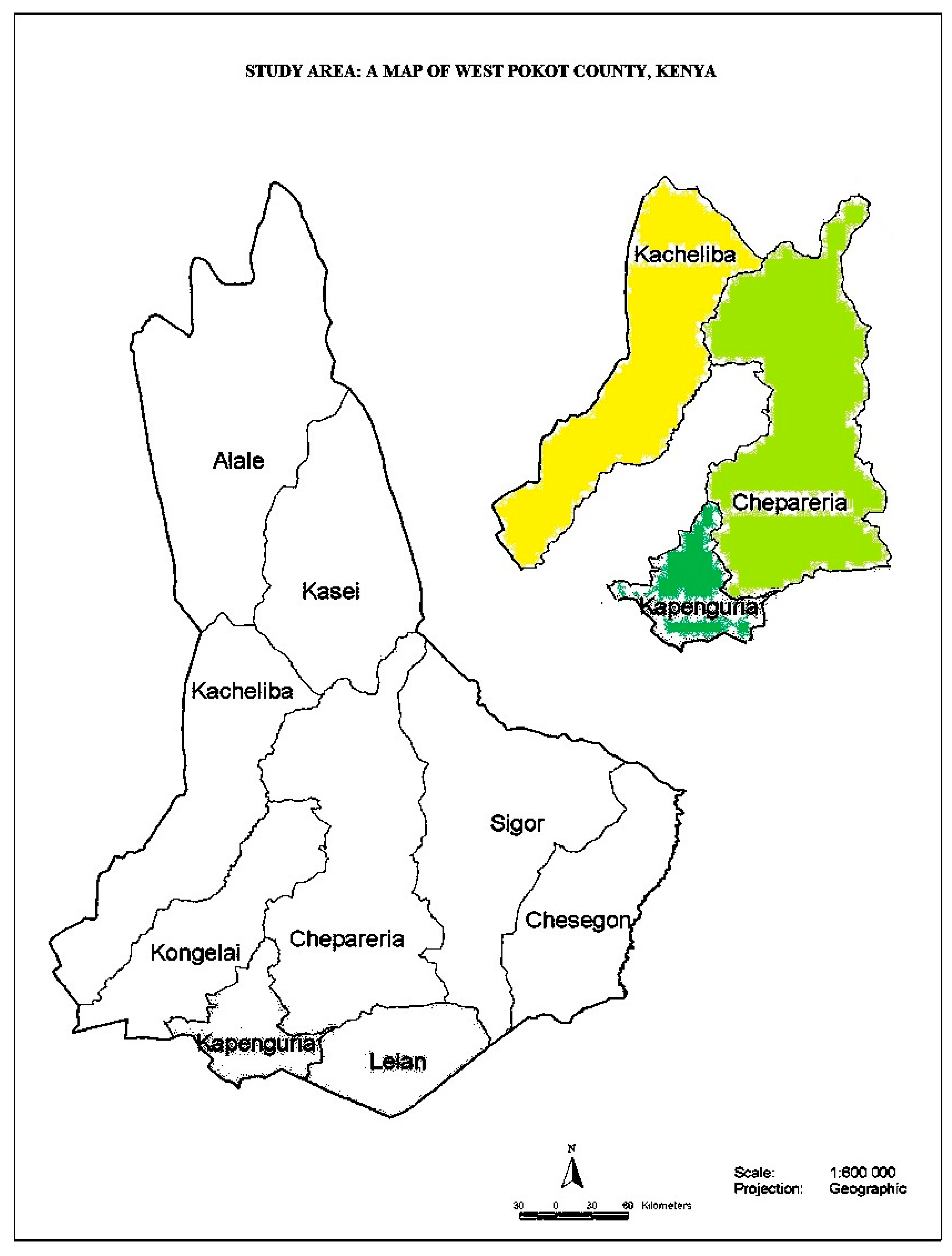
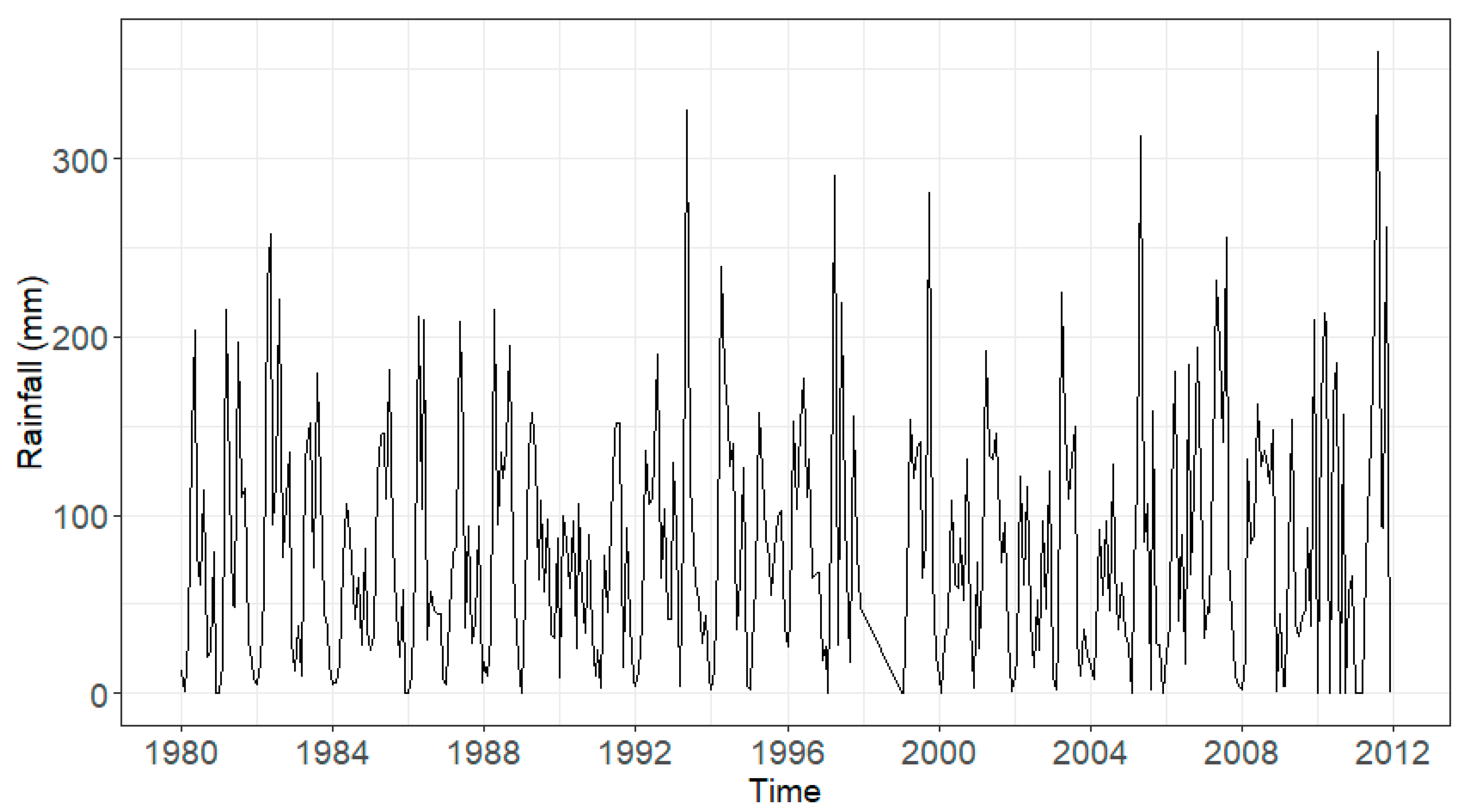
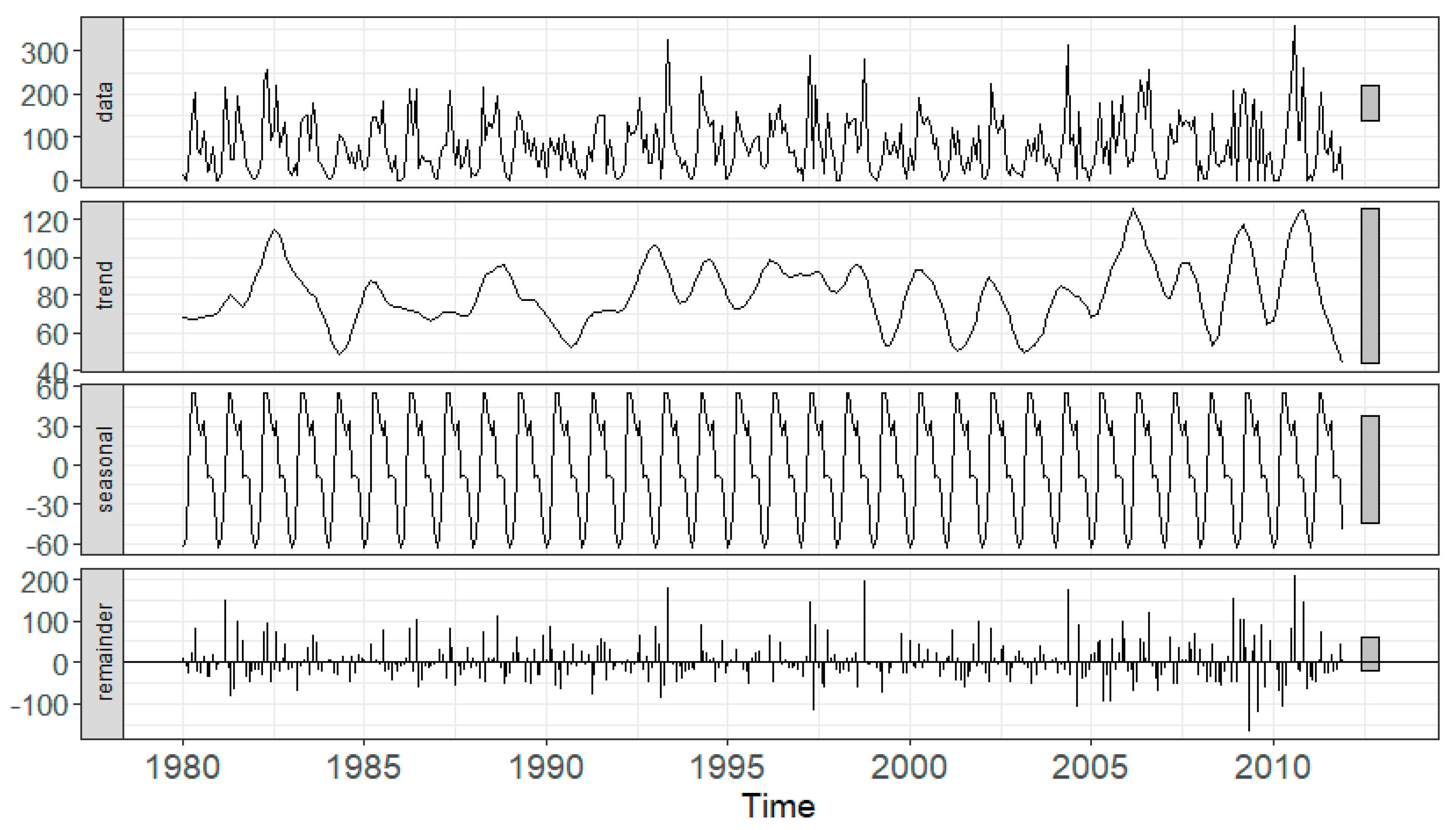


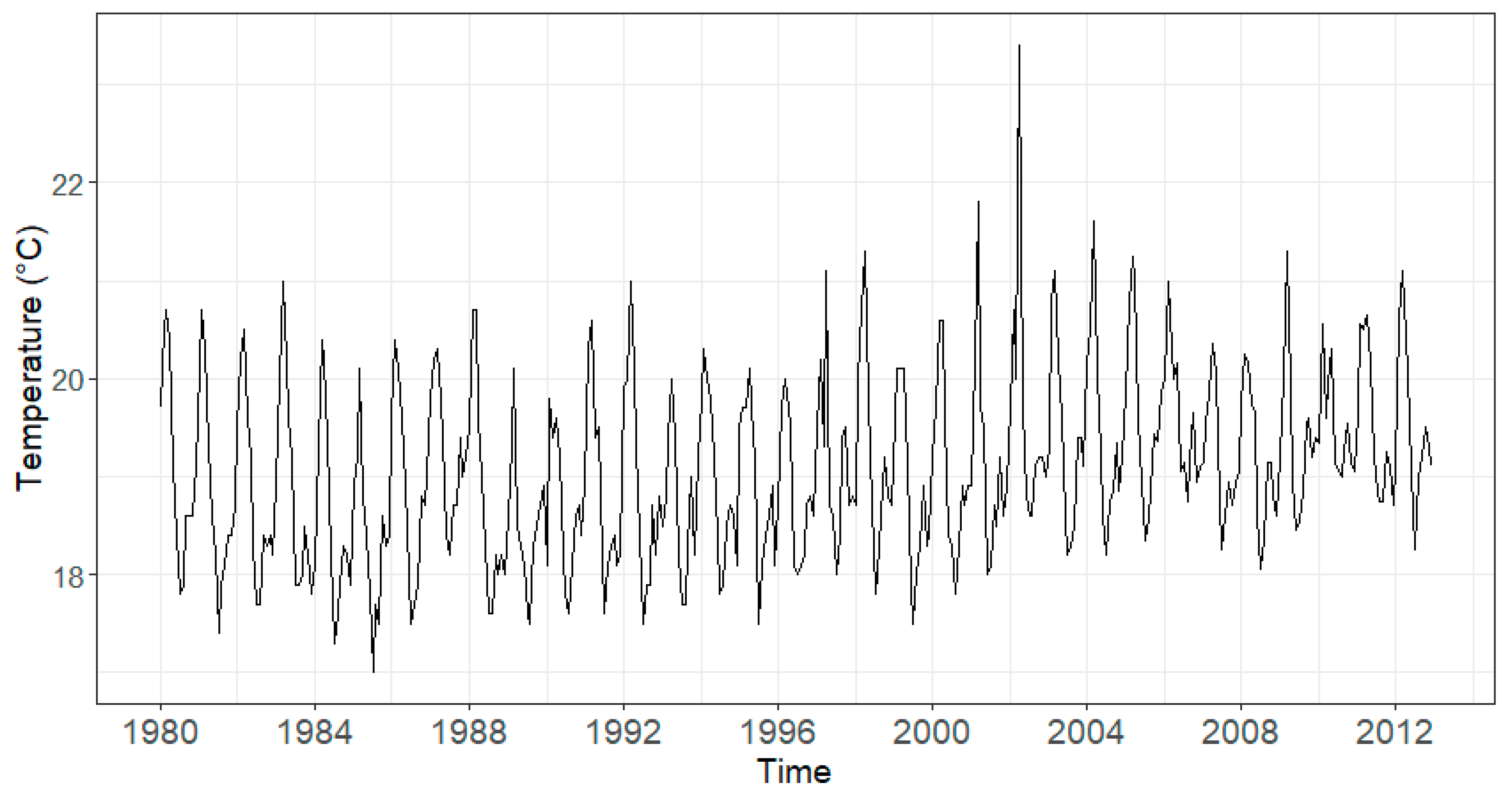
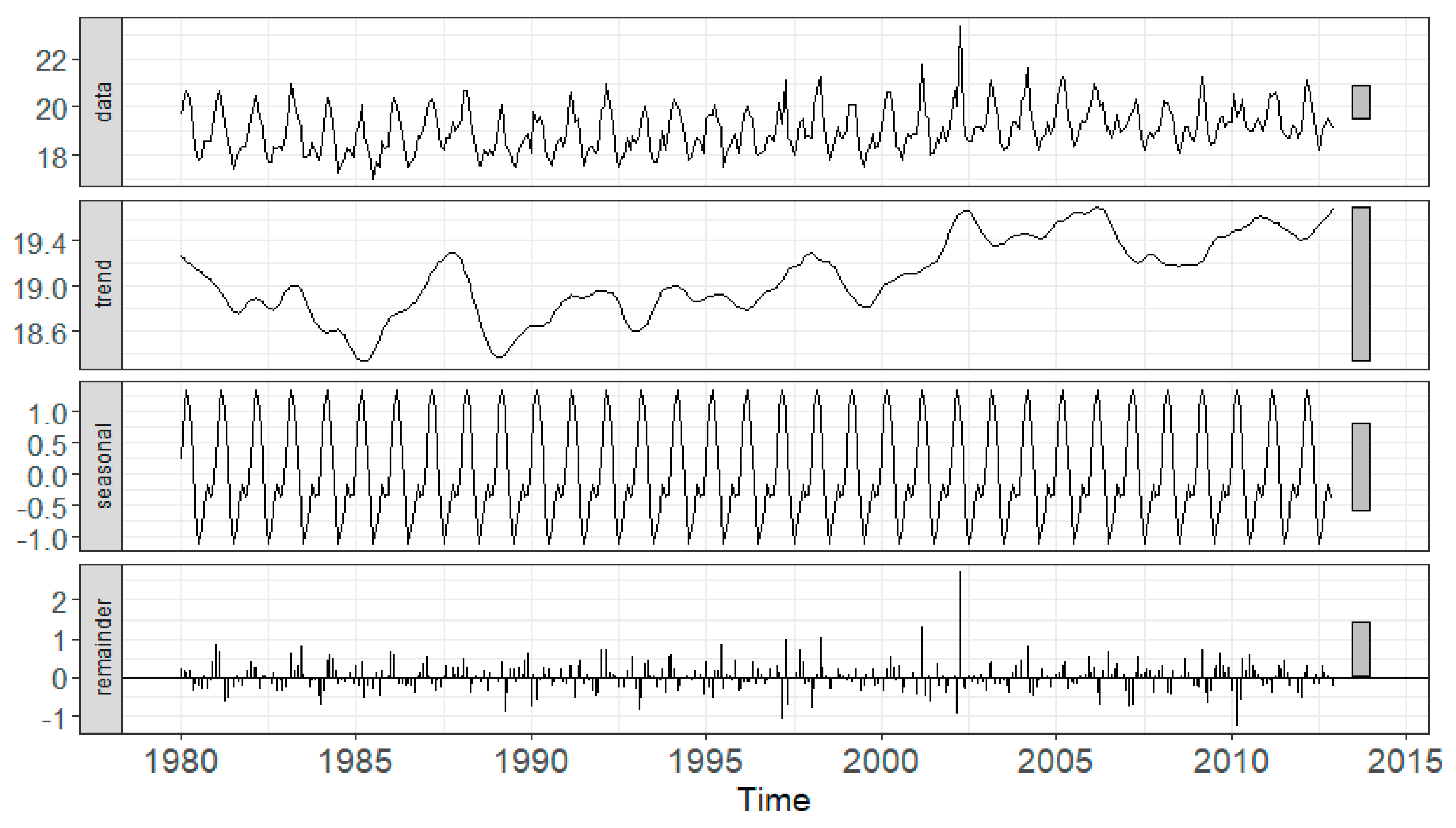


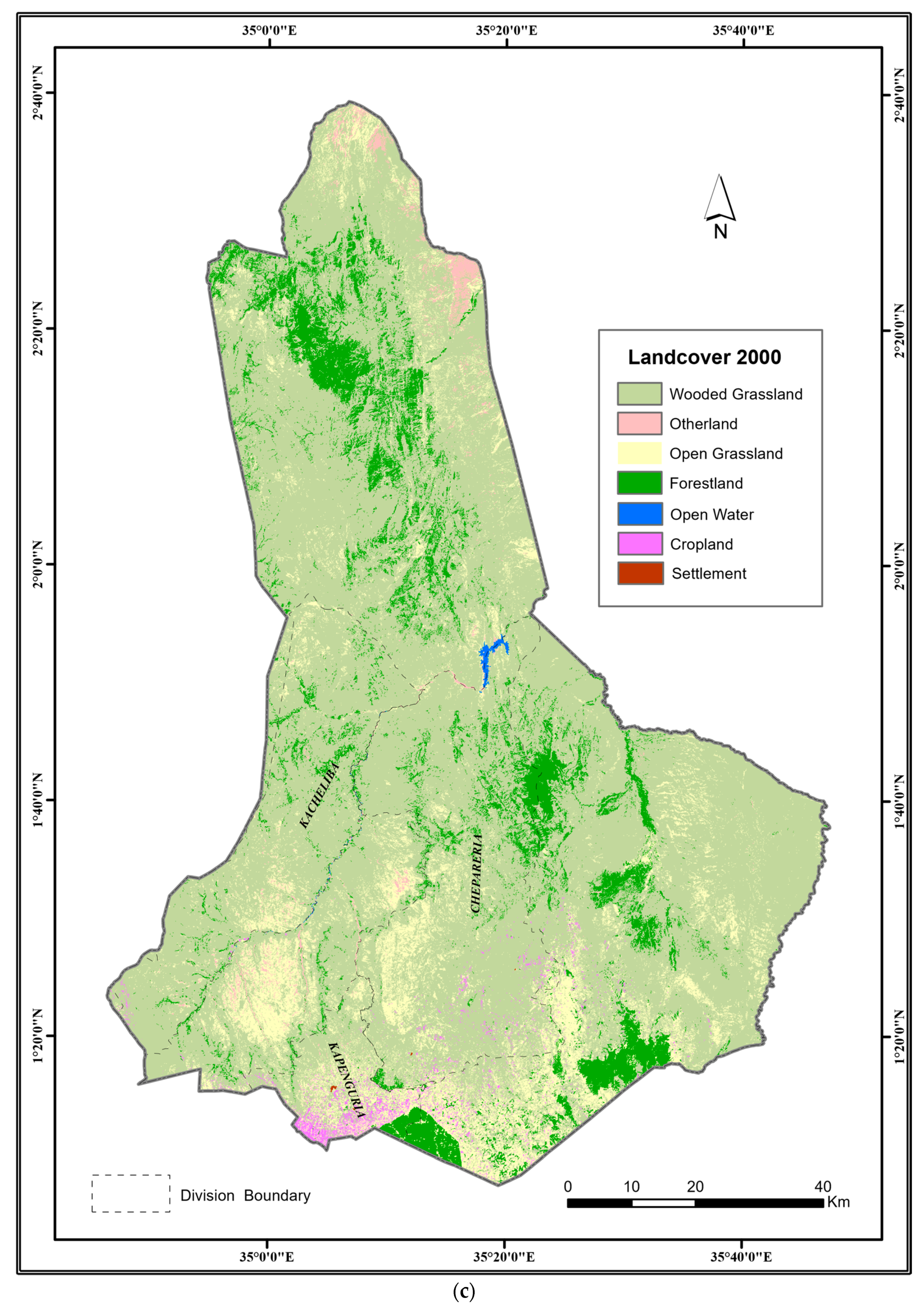
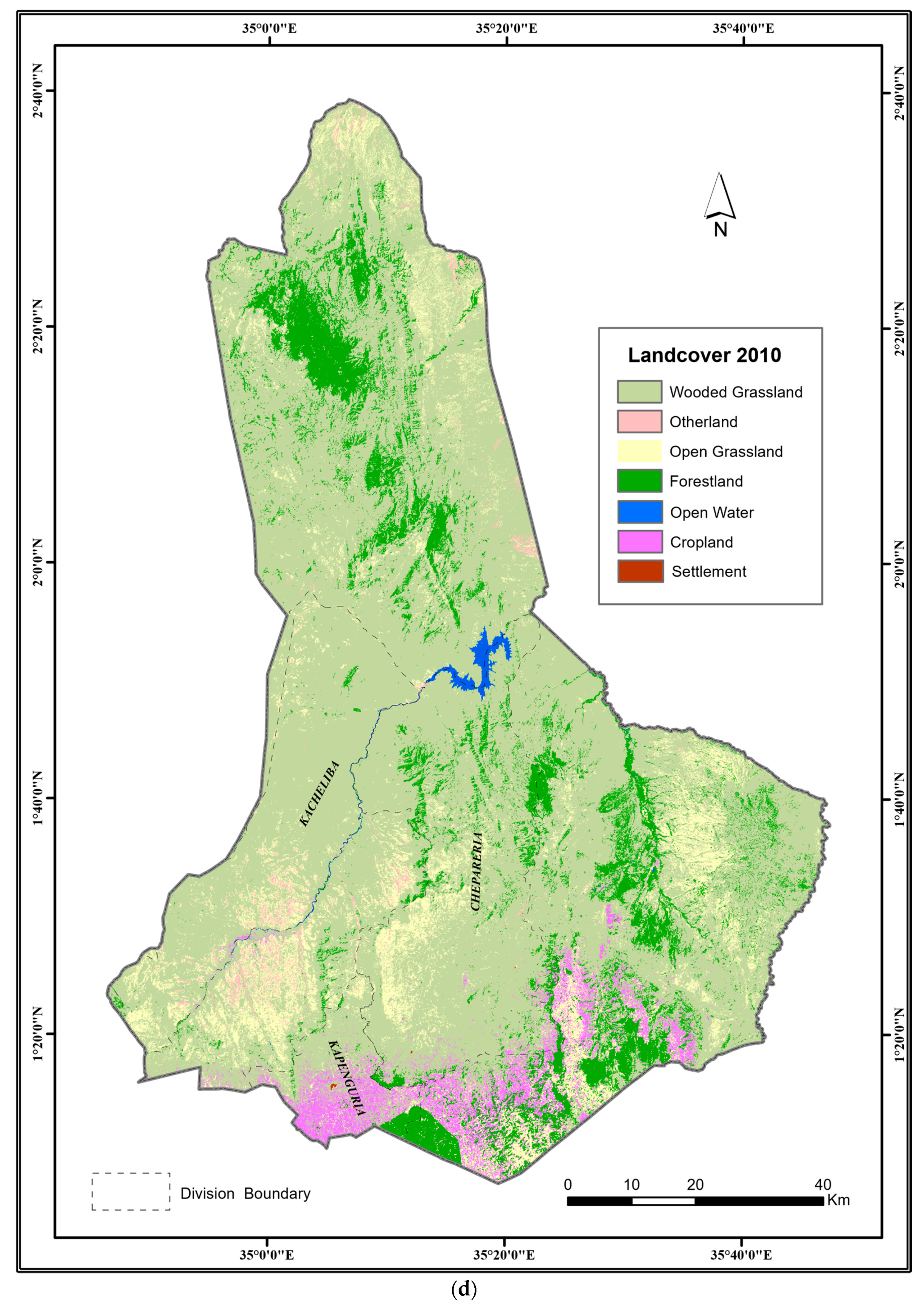


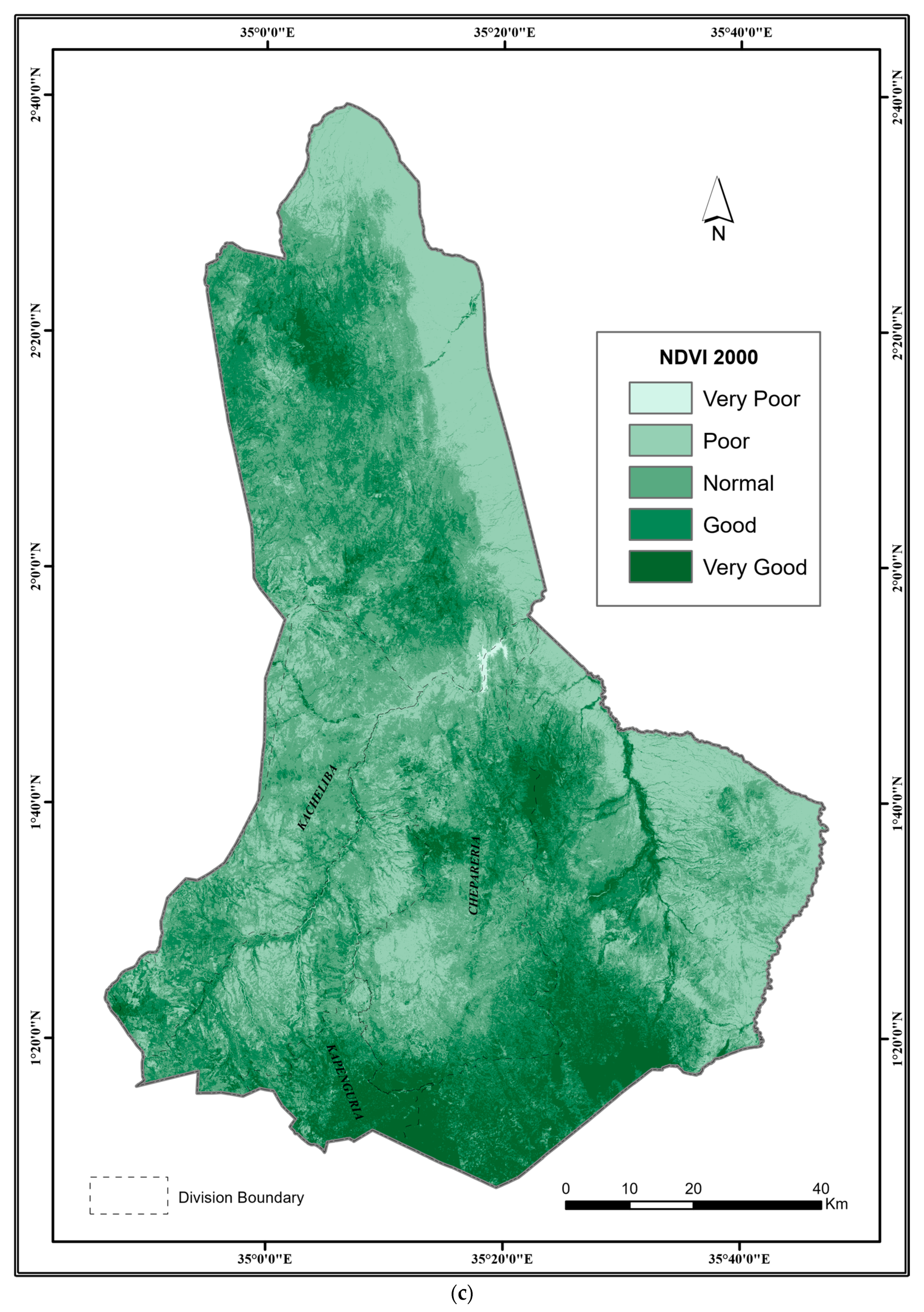
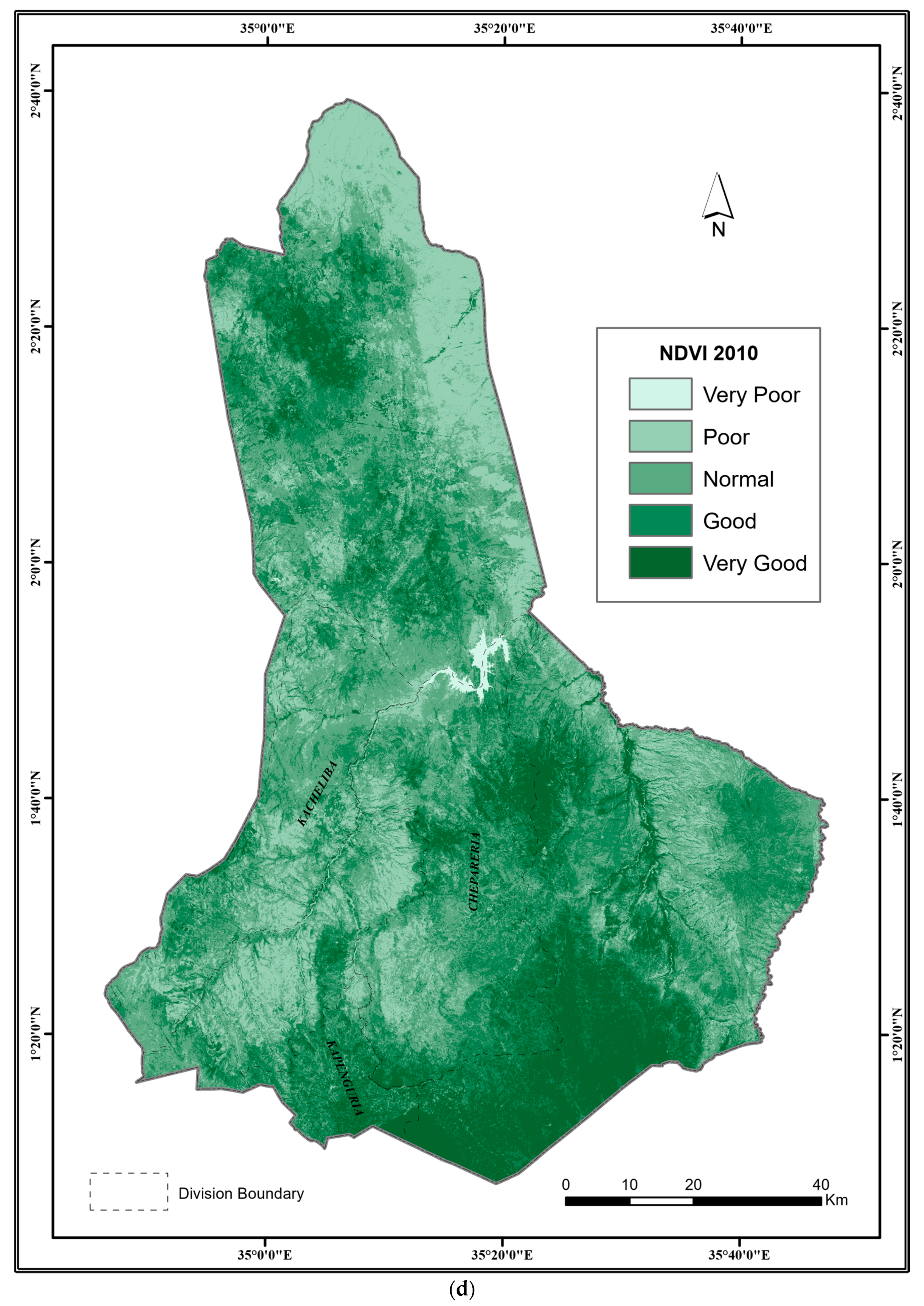

| Study Areas | Area (Square kms) | Agricultural Potential | Pokot Land Classification Type | Average Annual Rainfall (mm) | Average Annual Temperature (°C) |
|---|---|---|---|---|---|
| Kapenguria | 335.6 | Highland | Masop | 1600 | <21 |
| Chepareria | 495 | Midland | Kamas | 600 | 24 |
| Kacheliba | 925.4 | Lowland | Tow | 300–400 | 28 |
| Landuse/Area in Hectares (Ha) | 1984 | 1990 | 2000 | 2010 | Net Change |
|---|---|---|---|---|---|
| Cropland | 794 | 4938 | 8254 | 33,931 | +33,138 (+4176%) |
| Forestland | 169,452 | 122,004 | 86460 | 104,443 | −65,010 (−38%) |
| Open Grassland | 196,775 | 123,176 | 110502 | 99,787 | −96,988 (−49%) |
| Open Water | 1139 | 498 | 1070 | 3957 | +2818 (+247%) |
| Otherland | 32,058 | 9910 | 8978 | 9361 | −22,698 (-71%) |
| Settlements | 39 | 47 | 70 | 142 | +103 (+266%) |
| Wooded Grassland | 533,461 | 673,114 | 718,359 | 682,734 | 149,274 (+28%) |
| Class EVF | Settlement | Forestland | Cropland | Otherland | Open Grassland | Wetland | Wooded Grassland | Total |
|---|---|---|---|---|---|---|---|---|
| Settlement | 1 | 0 | 1 | 0 | 0 | 0 | 0 | 2 |
| Forestland | 0 | 8 | 0 | 0 | 0 | 0 | 0 | 8 |
| Cropland | 1 | 0 | 12 | 0 | 3 | 0 | 3 | 19 |
| Otherland | 0 | 1 | 0 | 5 | 0 | 0 | 0 | 6 |
| Open grassland | 0 | 0 | 0 | 0 | 2 | 0 | 0 | 2 |
| Wetland | 0 | 0 | 0 | 0 | 0 | 1 | 0 | 1 |
| Wooded grassland | 0 | 0 | 0 | 0 | 2 | 0 | 3 | 5 |
| Total Sampled Points | 2 | 9 | 13 | 5 | 7 | 1 | 6 | 43 |
| % Extent of Climate Change Effect on Food Production | ||||
|---|---|---|---|---|
| Kapenguria | Chepareria | Kacheliba | All % | |
| Greatly Affected | 14 | 27 | 75 | 34 |
| Slightly Affected | 84 | 66 | 25 | 63 |
| Did Not Affect | 2 | 7 | 0 | 3 |
| 100 | 100 | 100 | 100 | |
| Temporal Attributes of Growing Season Changes | Kapenguria | Chepareria | Kacheliba | All (%) |
|---|---|---|---|---|
| Shorter | 33 | 46 | 57 | 44 |
| Stayed the same | 55 | 39 | 9 | 38 |
| Longer | 12 | 15 | 6 | 11 |
| Much shorter | 0 | 0 | 0 | 0 |
| Much longer | 0 | 0 | 3 | 1 |
| Varies depending on rainfall occurrence | 0 | 0 | 25 | 6 |
| Agro-ecological zone | ||||
|---|---|---|---|---|
| Kapenguria | Chepareria | Kacheliba | All % | |
| Declined | 49 | 61 | 97 | 65 |
| Steady | 24 | 27 | 0 | 19 |
| Increased | 27 | 12 | 3 | 16 |
| Dependent Variable: Do You Take Any Measures to Reduce Your Exposure to The Impacts of Climate Change on Food Security Risk? | |||
|---|---|---|---|
| Coefficient | Std. Error | Odds (Exponential of Coefficient) | |
| Intercept | −22.655 | 1311.778 | ~0.00 |
| Gender of respondent (Male) | 1.863 *** | 0.591 | 6.443 |
| Acreage under crop farming | −0.350 ** | 0.160 | 0.705 |
| How has your production been over time since last year up to now? (Remained the same) | −1.345 ** | 0.640 | 0.260 |
| How has your production been over time since last year up to now? (Increased) | 0.736 | 0.804 | 2.087 |
| Do you have enough food for your household currently? (Yes) | 1.205 * | 0.696 | 3.338 |
| Has there been any project targeted at improving the food insecurity condition in your area? (Yes) | −1.680 *** | 0.648 | 0.186 |
| How would you rate the quantity of food in your household? (Bad) | 1.287 | 0.967 | 3.620 |
| How would you rate the quantity of food in your household? (Good) | 2.199 ** | 1.030 | 9.016 |
| How would you rate the quantity of food in your household? (Very good) | 5.430 * | 2.851 | 228.223 |
| Do you depend on relief food when size of land under crop production reduces (Yes) | 2.313 *** | 0.663 | 10.107 |
| How has climate change affected food production for your household since last year up to now? (Greatly affected) | 21.466 | 1311.778 | 2,102,432,864.730 |
| How has climate change affected food production for your household since last year up to now? (Slightly affected) | 20.910 | 1311.777 | 1,205,886,624.298 |
| Observations | 124 | ||
| Log Likelihood | −56.623 | ||
| Akaike Inf. Crit. | 139.245 | ||
| Dependent Variable: Do You Take Any Measures to Reduce Your Exposure to the Impacts of Climate Change on Food Security Risk? | |||
|---|---|---|---|
| Coefficient | Std. Error | Odds (Exponential of Coefficient) | |
| Intercept | −0.373 | 0.626 | 0.688 |
| Gender of respondent (Male) | 1.588 *** | 0.591 | 4.892 |
| Acreage under crop farming | −0.163 | 0.125 | 0.850 |
| How has your production been over time since last year up to now? (Remained the same) | −1.157 ** | 0.545 | 0.314 |
| How has your production been over time since last year up to now? (Increased) | 0.479 | 0.700 | 1.615 |
| Do you have enough food for your household currently? (Yes) | 1.493 *** | 0.563 | 4.449 |
| Has there been any project targeted at improving the food insecurity condition in your area? (Yes) | −1.226 ** | 0.531 | 0.293 |
| Do you depend on relief food when size of land under crop production reduces (Yes) | 1.903 *** | 0.551 | 6.708 |
| Observations | 124 | ||
| Log Likelihood | −64.536 | ||
| Akaike Inf. Crit. | 145.071 | ||
Publisher’s Note: MDPI stays neutral with regard to jurisdictional claims in published maps and institutional affiliations. |
© 2022 by the authors. Licensee MDPI, Basel, Switzerland. This article is an open access article distributed under the terms and conditions of the Creative Commons Attribution (CC BY) license (https://creativecommons.org/licenses/by/4.0/).
Share and Cite
Obwocha, E.B.; Ramisch, J.J.; Duguma, L.; Orero, L. The Relationship between Climate Change, Variability, and Food Security: Understanding the Impacts and Building Resilient Food Systems in West Pokot County, Kenya. Sustainability 2022, 14, 765. https://doi.org/10.3390/su14020765
Obwocha EB, Ramisch JJ, Duguma L, Orero L. The Relationship between Climate Change, Variability, and Food Security: Understanding the Impacts and Building Resilient Food Systems in West Pokot County, Kenya. Sustainability. 2022; 14(2):765. https://doi.org/10.3390/su14020765
Chicago/Turabian StyleObwocha, Everlyne B., Joshua J. Ramisch, Lalisa Duguma, and Levi Orero. 2022. "The Relationship between Climate Change, Variability, and Food Security: Understanding the Impacts and Building Resilient Food Systems in West Pokot County, Kenya" Sustainability 14, no. 2: 765. https://doi.org/10.3390/su14020765
APA StyleObwocha, E. B., Ramisch, J. J., Duguma, L., & Orero, L. (2022). The Relationship between Climate Change, Variability, and Food Security: Understanding the Impacts and Building Resilient Food Systems in West Pokot County, Kenya. Sustainability, 14(2), 765. https://doi.org/10.3390/su14020765







